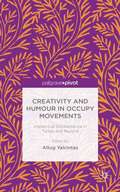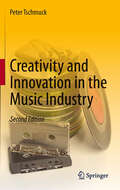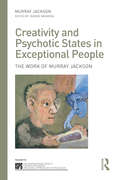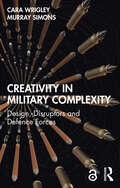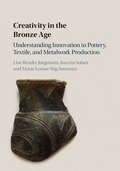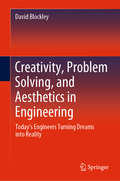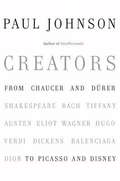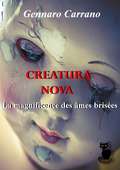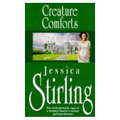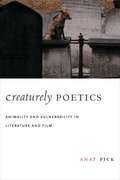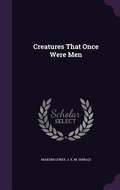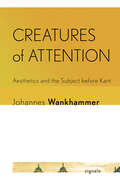- Table View
- List View
Creatively Expanding the Premodern: Historical and Literary Afterlives (New Interdisciplinary Approaches to Early Modern Culture)
by Carole Levin Christine Stewart-Nuñez Marguerite A. Tassi Julia GriffinThis book highlights the stories of women from premodern history and literature through models of adaptations, retellings, and criticism such as poems, plays, and essays. Reviving these voices from the background widens the appeal and accessibility of scholarship in the humanities.Creative composing processes draw research through the imagination and experience of the writer. This act can help explore qualities of historical events and literary figures that are still relevant today. The four authors of this book demonstrate these approaches through creative adaptations and responses to Biblical and Classical writings, Greek mythological figures, medieval narratives, powerful historical women, plays by Shakespeare, and works by other early modern English writers. What distinguishes this book from other scholarship on the premodern is its collaborative and interdisciplinary foundation, as well as its emphasis on literary and hybrid genres.Offering interdisciplinary ways of reading, thinking about, and reconceiving literature and scholarship in a way that invites dialogue and further creative responses, this volume provides humanities teachers with effective pedagogical tools to inspire deeper engagement and understanding in their students.
Creativity and Conflict Resolution: Alternative Pathways to Peace (Routledge Studies in Peace and Conflict Resolution)
by Tatsushi AraiThis book explores how creative ways of resolving social conflicts emerge, evolve, and subsequently come to be accepted or rejected in inter-group relations. Creativity and Conflict Resolution explores a subject with which political communities involved in social conflict have always grappled: creative ways of imagining and actualizing visions of conflict resolution. This is an ambitious question, which concerns human communities at many different levels, from families, regional-independence movements, and national governments, to inter-state alliances. The author argues that unconventional viability lies at the heart of creativity for transcending seemingly intractable inter-communal conflicts. More specifically, conflict resolution creativity is a social and epistemological process, whereby actors involved in a given social conflict learn to formulate an unconventional resolution option or procedure. Demystifying the origin of unthinkable breakthroughs for conflict resolution and illuminating theories of creativity based on 17 international case studies, this book will be of much interest to students of conflict resolution, peace and conflict studies, human security and IR. Tatsushi Arai is an Associate Professor of Peace and Conflict Transformation at the SIT Graduate Institute in Vermont, USA. He has a PhD in Conflict Resolution from George Mason University, Washington DC, and extensive practical experience in the field.
Creativity and Humour in Occupy Movements: Intellectual Disobedience in Turkey and Beyond
by Altug YalcintasThis volume offers scholarly perspectives on the creative and humorous nature of the protests at Gezi Park in Turkey, 2013. The contributors argue that these protests inspired musicians, film-makers, social scientists and other creative individuals, out of a concern for the aesthetics of the protests, rather than seizure of political power.
Creativity and Innovation in the Music Industry
by Peter TschmuckWhy did jazz become a dominant popular music genre in the 1920s and rock 'n' roll in the 1950s? Why did heavy metal, punk rock and hiphop find their way from sub-cultures to the established music industry? What are the effects of new communication technologies and the Internet on the creation of music in the early 21st century? These and other questions are answered by Peter Tschmuck through an integrated model of creativity and innovation that is based on an international history of music industry since Thomas A. Edison invented the phonograph in 1877. Thus, the history of the music industry is described in full detail. By discussing the historic process of music production, distribution and reception the author highlights several revolutions in the music industry that were caused by the inference of aesthetic, technological, legal, economic, social and political processes of change. On the basis of an integrated model of creativity and innovation, an explanation is given on how the processes and structures of the present music industry will be altered by the ongoing digital revolution, which totally changed the value-added network of the production, dissemination and use of music. For the second edition, the author has reworked chapter 9 in order to include all the developments which shaped the music industry in the first decade of the 21st century - from Napster to cloud-based music services and even beyond.
Creativity and Its Discontents: China’s Creative Industries and Intellectual Property Rights Offenses
by Laikwan PangCreativity and Its Discontents is a sharp critique of the intellectual property rights (IPR)-based creative economy, particularly as it is embraced or ignored in China. Laikwan Pang argues that the creative economy--in which creativity is an individual asset to be commodified and protected as property--is an intensification of Western modernity and capitalism at odds with key aspects of Chinese culture. Nevertheless, globalization has compelled China to undertake endeavors involving intellectual property rights. Pang examines China's IPR-compliant industries, as well as its numerous copyright violations. She describes how China promotes intellectual property rights in projects such as the development of cultural tourism in the World Heritage city of Lijiang, the transformation of Hong Kong cinema, and the cultural branding of Beijing. Meanwhile, copyright infringement proliferates, angering international trade organizations. Pang argues that piracy and counterfeiting embody the intimate connection between creativity and copying. She points to the lack of copyright protections for Japanese anime as the motor of China's dynamic anime culture. Theorizing the relationship between knockoffs and appropriation art, Pang offers an incisive interpretation of China's flourishing art scene. Creativity and Its Discontents is a refreshing rejoinder to uncritical celebrations of the creative economy.
Creativity and Psychotic States in Exceptional People: The work of Murray Jackson (The International Society for Psychological and Social Approaches to Psychosis Book Series)
by Murray JacksonCreativity and Psychotic States in Exceptional People tells the story of the lives of four exceptionally gifted individuals: Vincent van Gogh, Vaslav Nijinsky, José Saramago and John Nash. Previously unpublished chapters by Murray Jackson are set in a contextual framework by Jeanne Magagna, revealing the wellspring of creativity in the subjects’ emotional experiences and delving into the nature of psychotic states which influence and impede the creative process. Jackson and Magagna aim to illustrate how psychoanalytic thinking can be relevant to people suffering from psychotic states of mind and provide understanding of the personalities of four exceptionally talented creative individuals. Present in the text are themes of loving and losing, mourning and manic states, creating as a process of repairing a sense of internal damage and the use of creativity to understand or run away from oneself. The book concludes with a glossary of useful psychoanalytic concepts. Creativity and Psychotic States in Exceptional People will be fascinating reading for psychiatrists, psychotherapists and psychoanalysts, other psychoanalytically informed professionals, students and anyone interested in the relationship between creativity and psychosis.
Creativity and Universality in Language (Lecture Notes in Morphogenesis)
by Mirko Degli Esposti Eduardo G. Altmann François PachetThis book collects research contributions concerning quantitative approaches to characterize originality and universality in language. The target audience comprises researchers and experts in the field but the book may also be beneficial for graduate students. Creativity might be considered as a morphogenetic process combining universal features with originality. While quantitative methods applied to text and music reveal universal features of language and music, originality is a highly appreciated feature of authors, composers, and performers. In this framework, the different methods of traditional problems of authorship attribution and document classification provide important insights on how to quantify the unique features of authors, composers, and styles. Such unique features contrast, and are restricted by, universal signatures, such as scaling laws in word-frequency distribution, entropy measures, long-range correlations, among others. This interplay between innovation and universality is also an essential ingredient of methods for automatic text generation. Innovation in language becomes relevant when it is imitated and spread to other speakers and musicians. Modern digital databases provide new opportunities to characterize and model the creation and evolution of linguistic innovations on historical time scales, a particularly important example of the more general problem of spreading of innovations in complex social systems. This multidisciplinary book combines scientists from various different backgrounds interested in quantitative analysis of variations (synchronic and diachronic) in language and music. The aim is to obtain a deeper understanding of how originality emerges, can be quantified, and propagates.
Creativity in Military Complexity: Design, Disruptors and Defence Forces (Routledge Studies in Conflict, Security and Technology)
by Cara Wrigley Murray SimonsThis work offers a groundbreaking exploration of the urgent need for creativity and innovation in contemporary military thought.In an era characterised by the ceaseless flux of global dynamics, traditional paradigms of warfare have become increasingly obsolete. The pursuit of victory no longer lies in the fixation upon past conflicts but rather in the discerning assessment of and adaptation to the challenges that will shape the conflicts of tomorrow. This innovative work dissects the barriers that have thus far hindered the realisation of this potential. Furthermore, it challenges the status quo and advances a series of recommendations poised to steer international militaries towards success in the theatre of contemporary conflicts. Drawing from their extensive involvement with defence forces worldwide, the authors introduce concepts such as military design thinking as catalytic instruments of change. Through introspective reflections and real-world case studies, they present implications for mitigating cognitive biases, heralding a transformative epoch in military operations. It is this very transformation that furnishes militaries with the capacity to surge ahead of their adversaries, a capability proving to be indispensable in modern warfare.Offering a well-illuminated path for military entities to adapt and flourish within an ever-evolving global landscape, this book will be of much interest to students of military studies, security studies, and international relations, as well as military professionals and leaders in the field.The Open Access version of this book, available at http://www.taylorfrancis.com, has been made available under a Creative Commons Attribution-Non Commercial-No Derivatives (CC-BY-NC-ND) 4.0 license.
Creativity in the Bronze Age: Understanding Innovation in Pottery, Textile, and Metalwork Production
by Marie Louise Stig Sørensen Lise Bender Jørgensen Joanna SofaerStudies of creativity frequently focus on the modern era yet creativity has always been part of human history. This book explores how creativity was expressed through the medium of clay in the Bronze Age in the Carpathian Basin. Although metal is one of the defining characteristics of Bronze Age Europe, in the Carpathian Basin clay was the dominant material in many areas of life. Here the daily experience of people was, therefore, much more likely to be related to clay than bronze. Through eight thematic essays, this book considers a series of different facets of creativity. Each essay combines a broad range of theoretical insights with a specific case study of ceramic forms, sites or individual objects. This innovative volume is the first to focus on creativity in the Bronze Age and offers new insights into the rich and complex archaeology of the Carpathian Basin.
Creativity — A New Vocabulary (Palgrave Studies in Creativity and Culture)
by Vlad Petre Glăveanu Lene Tanggaard Charlotte WegenerCreativity — A New Vocabulary proposes a novel approach to the way in which we talk and think about creativity. It covers a variety of topics not commonly associated with creativity that offer us valuable insights and open up new and exciting possibilities for creative action. This second edition includes six new essays which continue to challenge the traditional vocabulary of creativity and its preference for individuals, brains, cognition, personality, divergent thinking, insight, and problem solving. The book proposes a more dynamic and relational perspective that considers creativity as an embodied, social, material, and cultural process. This book will be useful for a wide range of specialists within the humanities and social sciences, as well as practitioners from applied fields who are looking for novel ways, of thinking about and doing creative work.
Creativity, Problem Solving, and Aesthetics in Engineering: Today's Engineers Turning Dreams into Reality
by David BlockleyThis book illuminates what engineering is and how it relates to other disciplines such as art, architecture, law, economics, science, technology, and even religion. The author explains, from an intrinsic as well as descriptive perspective, why engineering is essential for our collective well-being, and how, like medicine, it is undertaken by people, and for people, to improve the human condition. He brings out the 'magic' of engineering practice as well as addressing the darker aspects such as warfare and the misuse of the internet. A too commonly held view assumes that the practice of engineers is a cold, purely quantitative and wholly technical enterprise of applying know science, and devoid of creativity or aestheticism. In 2013 the United States National Academy of Engineering launched a campaign called “Changing the Conversation, Messages for Improving Public Understanding of Engineering” with four messages to impart about engineers: that they make a world of difference; are creative problem solvers; that they help shape the future, and are essential to health, happiness, and safety. In this volume, Professor Blockley incorporate these messages into an engaging exposition of engineering accomplishment in all of its evolving diversity, from the technician to the academic research engineer, illustrating the continuum of thinking and purpose from the fixer of the gas boiler to the designers of the A380 and the iPhone.
Creators of Mathematical and Computational Sciences
by Ravi P Agarwal Syamal K SenThe book records the essential discoveries of mathematical and computational scientists in chronological order, following the birth of ideas on the basis of prior ideas ad infinitum. The authors document the winding path of mathematical scholarship throughout history, and most importantly, the thought process of each individual that resulted in the mastery of their subject. The book implicitly addresses the nature and character of every scientist as one tries to understand their visible actions in both adverse and congenial environments. The authors hope that this will enable the reader to understand their mode of thinking, and perhaps even to emulate their virtues in life.
Creators: From Chaucer and Durer to Picasso and Disney
by Paul JohnsonKingsley Amis described Paul Johnson's Intellectuals as "a valuable and entertaining Rogues' Gallery of Adventures of the Mind." Now the celebrated journalist and historian offers Creators, a companion volume of essays that examines a host of outstanding and prolific creative spirits. Here are Disney, Picasso, Bach, and Shakespeare; Austen, Twain, and T. S. Eliot; and Dürer, Hokusai, Pugin, and Viollet-le-Duc, among many others. Paul Johnson believes that creation cannot be satisfactorily analyzed, but it can be illustrated to bring out its salient characteristics. That is the purpose of this instructive and witty book.
Creatura Nova
by Gennaro CarranoA Imolada, A Gentil, Sensibilidade, Delicado, Eros, Pálida. Uma jornada poética para descobrir as várias facetas da alma humana, onde o bem é confundido com o mal, o amor se funde com ódio, o perdão se torna culpa. Qual o limite entre o certo e o errado? A consciência será realmente um juiz imparcial? Será a moralidade apenas um condicionamento social? Uma eterna luta entre o instinto e a razão... A Creatura Nova pretende, através do estilo e da temática, representar uma nova maneira de fazer poesia. Um estilo antigo que se fundiu com temas atuais e métodos modernos. Mais do qu com uma antologia, deparamo-nos com uma narrativa poética real. Pela primeira vez, um tema difícil, como o estupro incestuoso, é tratado na poesia. As principais temáticas são as facetas da alma humana, vistas sob vários pontos de vista. E 'dividido em 'capítulos': "A Imolada" e "A Gentil" são o âmago da narrativa poética, onde é narrada a história de Adelfo (do grego = adelphos irmão) que estupra a irmã Verginia. Esta vai encontrar forças para perdoá-lo mas também o perdão se pode tornar uma grande culpa, e serão essa, de fato, que elouquecerá o protagonista Adelfo. Outra peculiaridade são os narradores. Em "A Imolada", os dois primeiros poemas são narradas por um narrador externo e os dois últimos do ponto de vista interno, ou seja, o de Adelfo. A mesma coisa acontece no capítulo "A Gentil", onde nos dois primeiros poemas o narrador é externo e nos dois últimos é interno, isto é, temos o ponto de vista da irmã Verginia. Isso possibilita olhar para a história, para o carrasco e a vítima de diferrentes perpectivas. No momento em que os seus papéis se misturam, a vítima torna-se carrasco e o carrasco, vítima. Nos oito poemas está presente um elemento commum: o lírio, um símbolo de pureza. Os restantes, sempre divididas por tema, tratam de temas como o amor a Deus, erotismo, autoflagelação, feminicídio e abandono.
Creatura Nova La magnificence des âmes brisées
by Sonia Broyart Gennaro CarranoL'Immolata, la Gentile, Sensibilitade, Delicato, L'Eros, Pallida. Un voyage poétique à la recherche des différentes facettes de l'âme humaine où le bien et le mal, l'amour et la haine se confondent, où le pardon devient culpabilité. Où se trouve la frontière entre ce qui est juste et ce qui ne l'est pas ? La conscience est-elle réellement un jugement impartial ? La morale est-elle seulement un conditionnement de la société ? Une lutte éternelle entre instinct et raison... " Con Rassegnatio Et Assolutio Tollereresti Un Riprovevole Atto?" " Nell'Odiar Vivrei Angustiato!"
Creatura Nova - El Renacimiento de la Mariposa
by Roberto Carlos Pavón Carreón Gennaro CarranoLa Inmolada, la Gentil, Sensibilidad, Delicado, El Eros, Pálida. Un viaje poético al descubrimiento de las diversas facetas del alma humana, donde el bien se confunde con el mal, le amor se funde con el odio, el perdón se vuelve una culpa ¿Cuál es la frontera entre lo que es justo y lo que es incorrecto? ¿La conciencia es en verdad un juez imparcial? ¿La moral es únicamente un condicionamiento social? Una eterna lucha entre instinto y razón... " Con Rassegnatio Et Assolutio Tollereresti Un Riprovevole Atto?" " Nell'Odiar Vivrei Angustiato!" Criatura Nueva quiere por estilo y temática representar un modo nuevo de hacer poesía. Un estilo antiguo fusionado con temáticas actuales y modalidad modernas. Nos enfrentamos, de hecho, más que a una compilación a una verdadera y propia narrativa poética. Por primera vez viene afrontado en poesía un tema escabroso como el estupro incestuoso. Las temáticas principales son las facetas del alma humana, vistos bajo varios puntos de vista. Está subdividido en "capítulos": La Inmolada y la Gentil son el verdadero y propio fulcro de la narración poética, de donde viene la historia de Adelfo (del griego adelphos = hermano) que viola a la hermana Virginia, ella encontrará la fuerza para perdonarlo aunque el perdón también puede ser una gran culpa, será esto, de hecho, lo que hará enloquecer al protagonista Adelfo. Otra particularidad son los narradores en la Inmolada tenemos las primeras dos poesías narradas por un narrador externo y las últimas 2 desde el punto de vista interno, es decir el de Adelfo. Lo mismo sucede en los capítulos de "La Gentil", donde en las primeras 2 poesías, el narrador es externo y en las últimas dos es interno, o sea tenemos el punto de vista de la hermana Virginia. Es un modo para ver con varios ojos y bajo varios aspectos, la historia, el carnicero y víctima, a medida que estos papeles se mezclan, la
Creature Comforts: Book Two
by Jessica StirlingThe second novel in Stirling's historical saga brings to light yet more dark secrets, amorous entanglements and murder...Elspeth and Anna Patterson of Balnesmoor have both married well: Elspeth to a wealthy wool merchant, Anna to the son of a respected factor. But they are far from happy. The two married sisters, leading oddly parallel lives, find themselves entangled in a web of infidelity, scandal, and heartache in the midst of Wellington's Peninsular War on the continent.The story continues in Hearts of Gold.
Creature Comforts: Book Two (Patterson Family Saga)
by Jessica StirlingThe second novel in Stirling's historical saga brings to light yet more dark secrets, amorous entanglements and murder...Elspeth and Anna Patterson of Balnesmoor have both married well: Elspeth to a wealthy wool merchant, Anna to the son of a respected factor. But they are far from happy. The two married sisters, leading oddly parallel lives, find themselves entangled in a web of infidelity, scandal, and heartache in the midst of Wellington's Peninsular War on the continent.The story continues in Hearts of Gold.
Creaturely Poetics: Animality and Vulnerability in Literature and Film
by Anat PickSimone Weil once wrote that "the vulnerability of precious things is beautiful because vulnerability is a mark of existence," establishing a relationship between vulnerability, beauty, and existence transcending the separation of species. Her conception of a radical ethics and aesthetics could be characterized as a new poetics of species, forcing a rethinking of the body's significance, both human and animal. Exploring the "logic of flesh" and the use of the body to mark species identity, Anat Pick reimagines a poetics that begins with the vulnerability of bodies, not the omnipotence of thought. Pick proposes a "creaturely" approach based on the shared embodiedness of humans and animals and a postsecular perspective on human-animal relations. She turns to literature, film, and other cultural texts, challenging the familiar inventory of the human: consciousness, language, morality, and dignity. Reintroducing Weil's elaboration of such themes as witnessing, commemoration, and collective memory, Pick identifies the animal within all humans, emphasizing the corporeal and its issues of power and freedom. In her poetics of the creaturely, powerlessness is the point at which aesthetic and ethical thinking must begin.
Creatures Born of Mud and Slime: The Wonder and Complexity of Spontaneous Generation (Singleton Center Books In Premodern Europe Ser.)
by Daryn LehouxA history and analysis of the theory of spontaneous generation and how scientific thought progresses.We accept that, at some point in the history of our universe, living creatures emerged from nonliving matter. Yet from the time of Aristotle until the late nineteenth century, many people believed in spontaneous generation, that living creatures sprang into existence from rotting material. As Daryn Lehoux explains in this fascinating book, spontaneous generation was perhaps the last stand of the ancient scientific worldview.In Creatures Born of Mud and Slime, Lehoux shows that—far from being a superstitious, gullible, or simplistic belief—spontaneous generation was a sophisticated and painstakingly grounded fact that stood up to the best scientific testing. Starting with the ancient Greeks’ careful and detailed investigations into how animals are generated straight through to the early modern period, Lehoux brings to life the intellectual contexts, rivalries, observational evidence, and complex and fascinating theories that were used to understand and explain the phenomena.The book highlights both the weirdness and the wonder that lie at the heart of investigations into nature. Lehoux concludes with a new look at a set of conflicting experiments that demonstrate that even the best scientific evidence can end up muddying what we take to be the truth about the world. Creatures Born of Mud and Slime is a compelling look at how we understand conceptions of scientific change, truth, and progress.“A very well-written and well-researched book that grapples with the foundational questions of the history of Western philosophy.” —Justin E. H. Smith, author of The Philosopher: A History in Six Types“A historical tour de force . . . the author’s brilliant prose [makes] the reader appreciate at one time the strangeness and the persuasive power of outmoded scientific explanations.” —Paolo Savoia, Nuncius 34“Concise and accessible, Lehoux’s clarity and graceful prose make this book . . . a pleasure to delve into.” —James Strick, HOPOS 8
Creatures Born of Mud and Slime: The Wonder and Complexity of Spontaneous Generation (Singleton Center Books in Premodern Europe)
by Daryn LehouxHow did the concept of spontaneous generation survive for so long?We accept that, at some point in the history of our universe, living creatures emerged from nonliving matter. Yet from the time of Aristotle until the late nineteenth century, many people believed in spontaneous generation, that living creatures sprang into existence from rotting material. As Daryn Lehoux explains in this fascinating book, spontaneous generation was perhaps the last stand of the ancient scientific worldview. In Creatures Born of Mud and Slime, Lehoux shows that—far from being a superstitious, gullible, or simplistic belief—spontaneous generation was a sophisticated and painstakingly grounded fact that stood up to the best scientific testing. Starting with the ancient Greeks’ careful and detailed investigations into how animals are generated straight through to the early modern period, Lehoux brings to life the intellectual contexts, rivalries, observational evidence, and complex and fascinating theories that were used to understand and explain the phenomena.The book highlights both the weirdness and the wonder that lie at the heart of investigations into nature. Lehoux concludes with a new look at a set of conflicting experiments that demonstrate that even the best scientific evidence can end up muddying what we take to be the truth about the world. Creatures Born of Mud and Slime is a compelling look at how we understand conceptions of scientific change, truth, and progress.
Creatures That Once Were Men
by Maksim GorkyA collection of short stories by the popular and influential Russian author, a founder of the socialist realism literary method and arguably the greatest Russian literary figure of the 20th century. He wrote stories, plays, memoirs and novels which touched the imagination of the Russian people, and was the first Russian author to write sympathetically of such characters as tramps and thieves, emphasizing their daily struggles against overwhelming odds.
Creatures of Attention: Aesthetics and the Subject before Kant (Signale: Modern German Letters, Cultures, and Thought)
by Johannes WankhammerCreatures of Attention excavates the early modern prehistory of our late modern crises of attention. At the threshold of modernity, philosophers, scientists, and poets across Europe began to see attention as the key to autonomous agency and knowledge. Recovering the philosophical and literary works from eighteenth-century Germany in which "attention," "subject," and "aesthetics" developed their modern meanings, Johannes Wankhammer examines control over attention as the cultural technique underpinning the ideal of individual autonomy. Aesthetics, founded by Alexander Baumgarten as a science of sense perception, challenged this ideal by reframing art as a catalyst for alternative modes of selfhood and attention. While previous scholarship on the history of attention emphasized the erosion of subjectivity by industrial or technological modernization, Wankhammer asks how attention came to define subjectivity in the first place. When periodically recurring crises of attention threaten the coherence of the subject, the subject comes undone at the very seams that first sutured it together. Creatures of Attention offers the first systematic study of a foundational discourse on attention from 1650 to 1780. Presenting pre-Kantian aesthetics as a critique of the Enlightenment paradigm of strained attention, the book offers a fresh perspective on poetics and aesthetics in eighteenth-century Germany.
Creatures of Cain: The Hunt for Human Nature in Cold War America
by Erika Lorraine MilamHow Cold War America came to attribute human evolutionary success to our species' unique capacity for murderAfter World War II, the question of how to define a universal human nature took on new urgency. Creatures of Cain charts the rise and precipitous fall in Cold War America of a theory that attributed man’s evolutionary success to his unique capacity for murder.Drawing on a wealth of archival materials and in-depth interviews, Erika Lorraine Milam reveals how the scientists who advanced this “killer ape” theory capitalized on an expanding postwar market in intellectual paperbacks and widespread faith in the power of science to solve humanity’s problems, even to answer the most fundamental questions of human identity. The killer ape theory spread quickly from colloquial science publications to late-night television, classrooms, political debates, and Hollywood films. Behind the scenes, however, scientists were sharply divided, their disagreements centering squarely on questions of race and gender. Then, in the 1970s, the theory unraveled altogether when primatologists discovered that chimpanzees also kill members of their own species. While the discovery brought an end to definitions of human exceptionalism delineated by violence, Milam shows how some evolutionists began to argue for a shared chimpanzee-human history of aggression even as other scientists discredited such theories as sloppy popularizations.A wide-ranging account of a compelling episode in American science, Creatures of Cain argues that the legacy of the killer ape persists today in the conviction that science can resolve the essential dilemmas of human nature.
Creatures of Charm And Hunger (The Diabolist's Library #3)
by Molly Tanzer“A compelling, fun, and thought-provoking story of magical adventure, coming of age, sacrifice, and family, with secrets that add a lingering darkness to the entire tale.”— BooklistTwo young witches, once inseparable, are set at odds by secrets and wildly dangerous magicIn the waning days of World War II, with Allied victory all but certain, desperate Nazi diabolists search for a demonic superweapon to turn the tide. A secluded castle somewhere in the south of Germany serves as a laboratory for experiments conducted upon human prisoners, experiments as vile as they are deadly.Across the English Channel, tucked into the sleepy Cumbrian countryside, lies the Library, the repository of occult knowledge for the Société des Éclairées, an international organization of diabolists. There, best friends Jane Blackwood and Miriam Cantor, tutored by the Société’s Librarian—and Jane’s mother—Nancy, prepare to undergo the Test that will determine their future as diabolists.When Miriam learns her missing parents are suspected of betraying the Société to the Nazis, she embarks on a quest to clear their names, a quest involving dangerous diabolic practices that will demand more of her than she can imagine. Meanwhile Jane, struggling with dark obsessions of her own, embraces a forbidden use of the Art that could put everyone she loves in danger.As their friendship buckles under the stress of too many secrets, Jane and Miriam will come face to face with unexpected truths that change everything they know about the war, the world, and most of all themselves. After all, some choices cannot be unmade--and a sacrifice made with the most noble intention might end up creating a monster.


